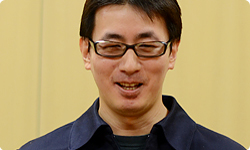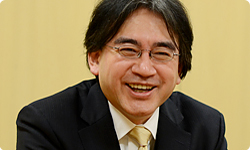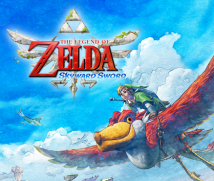4. Link Over the Edge
This Legend of Zelda game is exactly what its name suggests, and while Zelda isn’t a princess this time, she is heavily featured.
Yes. Mori-san has really dedicated himself to how to portray Zelda. That was true for Tetra in The Legend of Zelda: Phantom Hourglass4, Princess Zelda in The Legend of Zelda: Spirit Tracks5 and, to go back even further, The Legend of Zelda: Ocarina of Time.6 4The Legend of Zelda: Phantom Hourglass: A stylus-controlled action-adventure game released in June 2007 in Japan as the first title in the Legend of Zelda series for the Nintendo DS system. 5The Legend of Zelda: Spirit Tracks: A stylus-controlled action-adventure game released for the Nintendo DS system in December 2009. 6The Legend of Zelda: Ocarina of Time: An action-adventure game released for the Nintendo 64 system in November 1998 in Japan.
Mori-san, what were you in charge of for The Legend of Zelda: Ocarina of Time?
I was director of cinematics.
Some people are still playing it, so I can’t be too specific, but the last scene.
Yes?
He just couldn’t settle on an expression for her face.
Yes, that’s right.
Did you eventually find something that satisfied you?
That was for the Nintendo 64 system, so there were hardware limitations to what we could express.
There were severe constraints on representing facial expressions on the characters.
Yes. I asked about adding one more expression for eyes, but they said it was impossible.
You couldn’t do it the way you wanted.
I proceeded with what was available, but it just didn’t look right to me. I ended up frustrated to the very end.
Ever since, Mori-san has wanted Zelda to have more vivid facial expressions.
That’s right. Later on, I worked on storyboards based upon scripts that others had written, but The Legend of Zelda: Spirit Tracks was the first time I wrote scripts for cinematic scenes. That was fairly...
Fairly what?
(looking slightly embarrassed) I thought, “Yes! This is my Zelda!!”

(laughs)
Oh! I like that honesty! (laughs) He talked earlier about breathing life into the characters, and I knew Mori-san would portray Zelda so she would possess a great deal of charm. This time there are also Mori-isms.
Mori-isms?
Here and there, you run across wording that we call Mori-isms.
Sometimes I can even cry a little from his writings. I’ll say, “So he decided to put this line here?” (laughs) They really hit home. Like, there are several places where I thought, “Ah, these are Mori-isms.” Those wouldn’t be possible if it weren’t for Mori-san, who has portrayed Zelda for so long.
Because of that, when I wrote the synopsis, I left some places blank on purpose so Mori-san could fill them in.
You wanted him to fill them in with Mori-isms. (laughs)
Yes. I wanted to leave the blanks to him. But I have my own preferences, so I wrote those places where I thought, “I definitely want this line to go in!”
And those are Maro-isms? (laughs)
Well, we were a good duo and worked well off each other. (Editor’s note: “Maro-ism” is a play on words taken from the last part of Fujibayashi-san’s first name Hidemaro to contrast with the Mori-ism mentioned earlier.)
Yes. But Fujibayashi-san can be really particular, too. For example, Zelda has a slightly mischievous side to her this time. In order to emphasise that personality, there’s an early scene in Fujibayashi-san’s script where she pushes Link off Skyloft!
Zelda shoves Link over the edge?!
Yes. For some reason or another, she did it about three times.
Three times?! (laughs)

Yes, because you can only repeat the same gag three times. (laughs)
I did that for two reasons. One was, as Mori-san just mentioned, that I wanted to give Zelda a mischievous personality, and the other is that I wanted to emphasise how they were up in the sky.
Such a scene arose because the first setting is up in the sky.
I wanted to emphasise how they were living someplace really high. But it is true that we’ve never had anyone push Link off from a high place before.
If he fell from the sky, he would die, so as a bit of mischief, I wondered, “Isn’t that going a bit far?!” (laughs)
I wanted to show how such occurrences were an everyday thing on Skyloft. If someone pushed you and you fell, your Loftwing would intercept you in the air.
I guess you wouldn’t die.
And you like that kind of thing, right, Mori-san? I mean, girls pushing around boys.
Huh? Well... (laughs)
(laughs)
So I told Mori-san to do a good job putting it together, and passed on to him the ingredient of Zelda pushing Link three times.
When I received that ingredient, I understood that it was something that happened on a daily basis, but even Link would panic if he got pushed off all of a sudden.
It would be surprising.
You’d really let out a scream, right? No matter how often it happened, it wouldn’t look right if Link just calmly accepted it with an unconcerned expression. I went to put in Link’s reaction, but when Miyamoto-san saw that he said, “Why is Link so surprised?” and “This is normal on Skyloft, right?” I thought, “Yes, I guess he’s right.”
But it would be strange to stay calm when pushed off like that.
Yes. I wondered how I should make it look, but Miyamoto-san thought of a reason for why Link would be surprised when pushed off.
He didn’t just say, “Why is he surprised?” He also came up with an idea for you.
Yes.
So we fixed up the beginning a lot.
Yes. Many times.
Miyamoto-san said it just didn’t strike the right note. In the end, we have decreased the number of times Zelda pushes Link off to two.
When Miyamoto-san makes his final check, he pays a lot of attention to how it will look to people playing in that world for the first time.
Yes, he does.
The longer development lasts, the harder it becomes for the staff to see that. One of Miyamoto-san’s important roles is viewing the game from the perspective of a first-time player.
Yes. We were really thankful for that.
We reworked that scene over and over, so I hope everyone will pay attention when Zelda pushes Link off Skyloft! (laughs)
